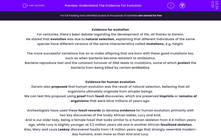Evidence for evolution
For centuries, there’s been debate regarding the development of life, all thanks to Darwin.
He stated that evolution was due to natural selection, explaining that different individuals of the same species have different versions of the same characteristics called mutations, e.g. height.
The more successful variations live on to make offspring that are born with these good mutations too, such as when bacteria become resistant to antibiotics.
Bacteria reproduce fast and the constant turnover of DNA leads to mutations, some of which protect the bacteria from being killed by certain antibiotics.
Evidence for human evolution
Darwin also proposed that human evolution was the result of natural selection, believing that all organisms ultimately originate from simpler beings.
We can test this proposal using proof from fossil discoveries, which are preserved imprints or remains of organisms that were alive millions of years ago.
Archeologists have used these fossil records to develop evidence for human evolution, primarily with two key discoveries of the lovely African ladies, Lucy and Arid.
Arid is our older lady, being a female fossil that looks similar to a human skeleton from 4.4 million years ago, while Lucy is slightly younger at 3.2 million years old and is another African fossilised skeleton.
Also, Mary and Louis Leakey discovered fossils from 1.6 million years ago that strongly resemble modern-day humans, even more so than Arid and Lucy.
Another sign that we have evolved over time is the discovery of stone tools, but their ages are only estimated as scientists can only consider the tool as old as the rock around it.
From five kingdoms to three domains using genetic analysis
To organise the information gathered from fossils and living organisms, beings are classified.
An early model was the seven group Linnaean system, categorising organisms into gradually smaller groups, the first group being the five kingdoms.
However, the Linnaean system was founded on human judgement, while scientific advances have now revealed more microscopic details to organisms, updating classification to the genetic level!
Genetic analysis uses DNA to contrast the relations between beings, leading a scientist,Carl Woese, to propose the three domain system instead of the five kingdoms.
Let's move on to some questions now to see how much you can remember.








